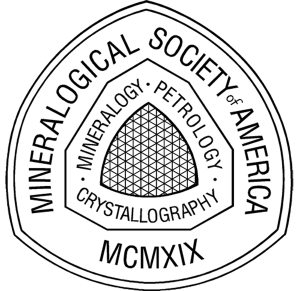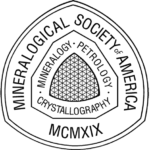

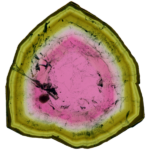

25% DISCOUNT
for MSA, CMS and GS members,
Excluding Shipping
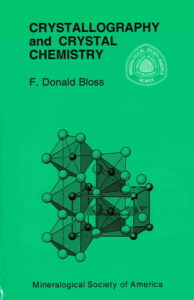

Crystallography and Crystal Chemistry
An Introduction (Print Version)
ISBN 0-939950-37-5
F. Donald Bloss
Holt, Rinehart and Winston first published Crystallography and Crystal Chemistry: An Introduction, in 1971 and it is still in use after 51 years. Because of its popularity as an undergraduate text MSA reprinted it in 1994 and again in 2000 as a paperback with minor revisions from the 1971 text.
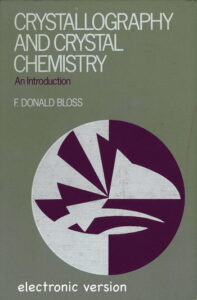

Crystallography and Crystal Chemistry
An Introduction (Electronic Version)
ISBN 978-1-946850-04-1
F. Donald Bloss
An electronic version as a pdf of the MSA 2000 reprint with the minor revisions from the 1971 text.
Contents of Crystallography and Crystal Chemistry
- Chapter 1. External Symmetry
- Chapter 2. Crystal Classes, Axes, and Systems
- Chapter 3. Crystal Nomenclature and Calculations
- Chapter 4. Crystal Projections
- Chapter 5. Crystal Forms and Class Determination
- Chapter 6. Translational Symmetry: Lattices
- Chapter 7. Internal Symmetry: Space Groups
- Chapter 8. Crystal Chemistry
- Chapter 9. Principles of Crystal Structures
- Chapter 10. Structural Variations, Composition, and Stability
- Chapter 11. Physical Properties
- Chapter 12. Crystal and Light
- Chapter 13. Introductory X-Ray Crystallography
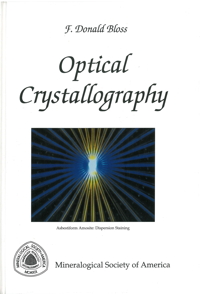

Optical Crystallography
F. Donald Bloss
(Reprinted 1999) 239 pages. ISBN 0-939950-49-9.
An Introduction to the Methods of Optical Crystallography, by F. Donald Bloss, was first published in 1961. That edition still stands as a classic in the field. It is technically sound and the explanations are, for the most part, clear and understandable even to a typical sophomore-level geology major. The 1961 edition was reprinted, but not revised, in 1967, and for many years it remained a widely used textbook for undergraduate courses in optical mineralogy.


Optical Crystallography
An Introduction (Electronic Version)
ISBN 978-1-946850-07-2
F. Donald Bloss
An electronic version as a pdf of the MSA 1999 reprint with the minor revisions and updates.
Contents of Optical Crystallography
- Preface
- Chapter 1. Light and Related Phenomena
- Chapter 2. Light in Isotropic Media
- Chapter 3. Lenses and the Compound Microscope
- Chapter 4. The polarizing Light Microscope
- Chapter 5. Optical Examination of Isotropic Substances
- Chapter 6. Optical Indicatrices and Ellipses
- Chapter 7. The Interference of Light
- Chapter 8. Optical Examination of Uniaxial Crystals
- Chapter 9. Introducing the Spindle Stage
- Chapter 10. Biaxial Crystals Overview Introduction Biaxial Indicatrix
- Chapter 11. Optical Examination of Biaxial Crystals
- Chapter 12. Spindle Stage Study of Biaxial Crystals
- Chapter 13. Rapid Optical Determination of Asbestos Fibers by Dispersion Staining
- Appendix I: Data for Cargille Liquids
- Appendix II: Properties of Ellipses
- Appendix III: Recording Data
- References Cited
- Index


Optical Crystallography Simplified – The spindle stage: Principles and Practice
F. Donald Bloss
(2017) i-xii + 340 pages. ISBN 978 0939950 43 0.
This book describes methods for the optical characterization of crystals as well as for supplementing the more conventional methods of determining crystal structure, such as X ray.
The spindle stage permits extremely accurate determination of the orientation of crystals under polarized light. The increased precision of spindle-stage techniques allows analyses of the close relationship between the composition of a crystal and its optical properties. This means that experimental errors are less likely to mask the effect on the optical properties caused by the minor compositional variations superimposed on the primary composition of a solid solution series.
For amateur mineralogists, the conoscopic and the graphic methods for analyzing extinction data described in the first three chapters are generally sufficient, whereas professional and forensic microscopists who desire greater accuracy may prefer to use the statistical methods and computer programs discussed in the later chapters. No other book deals exclusively and in such detail with the spindle stage. This volume will be welcomed by graduate students and professionals in mineralogy, crystallography, and petrology.
The Programs


Microsoft Excel spreadsheet version EXCELIBR (Steven and Gunter, 2018) solves for the optical orientation of biaxial or uniaxial minerals using extinction data. The guidebook, Orienting and Measuring the Optical Properties of Crystals, demonstrates how to use EXCELIBR with a few example methods, while also demonstrating practical skills in optical crystallography.
- (EXCELIBR_CCW.xlsx) for counter clockwise-increasing stages
- (EXCELIBR_CW.xlsx) for clockwise-increasing stages
- (EXCELIBR axes) for counter clockwise-increasing stages and plotting crystal axes of monoclinic and triclinic minerals
- Orienting and Measuring the Optical Properties of Crystals by Cody Steven (21 MB size).
The Windows-based version of EXCALIBRII was EXCALIBRW (Gunter et al., 2005). It is mathematically more robust in its solution algorithms, and provides solutions for crystals in less favorable orientations than the earlier versions of EXCALIBR, and has a stereographic output.
EXCALIBRII (Bartelmehs, Bloss, Downs, and Birch, 1992). Like the original EXCALIBR, it solves optical extinction data, but uses a modification to Joel’s equation as a means of obtaining the optic axes of a crystal. The new algorithm eliminates the need to solve the extinction data, quartet by quartet, as the first step towards finding a solution, as required by EXCALIBR. Furthermore, EXCALIBR II successfully solves extinction data where one optic axis of a biaxial crystal is 90° to the spindle axis, an orientation that had thwarted its predecessor. EXCALIBR II also accurately determines the optical indicatrix orientation for uniaxial crystals.
References
- John L Rosenfeld (1935) Determination of all principal indices of refraction on difficultly oriented minerals by direct measurement, American Mineralogist v. 35, 902-905. (paper)
- Bloss, F. and Riess, D. (1973). Computer determination of 2v and indicatrix orientation from extinction data, American Mineralogist v. 58, 1052–1061. (paper)
- Gunter, Mickey E, F. Donald Bloss, and Shu-Chun Su (1988) EXCALIBR revisted, American Mineralogist v.73, 1481-1482. (paper)
- K. L. Bartelmehs, F. D. Bloss, R. T. Downs, and J. B. Birch (1992) EXCALIBR II, Zeitschrift für Kristallographie, Volume 199, Issue 3-4, Pages 185–196. (link)
- Mickey E. Gunter, Bryan R. Bandli, F. Donald Bloss, Stanley H. Evans, Shu-Chun Su, and Robert Weaver (2004) Results from a McCrone Spindle Stage Short Course, a New Version of EXCALIBR, and How to Build a Spindle Stage, MICROSCOPE Vol 52:1 23-39. (link)
- Mickey E. Gunter, Robert T. Downs, Kurt L. Bartelmehs, Stanley H. Evans, Carolyn J.S. Pommier, Jack S. Grow, Matthew S. Sanchez, and F. Donald Bloss (2005) Optic properties of centimeter-sized crystals determined in air with the spindle stage using EXCALIBRW, American Mineralogist v. 90, 1648-1654 (abstract)
- Cody J. Steven and Mickey E. Gunter (2018) EXCELIBR: An Excel Spreadsheet for Solving the Optical Orientation of Uniaxial and Biaxial Crystals, The Microscope 65 (4), pp 147–152. (link)
- Technical Enterprises, The Detent Spindle Stage (paper)
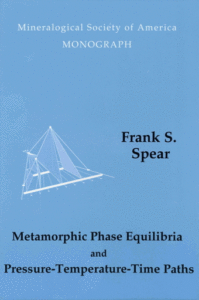

Metamorphic Phase Equilibria And Presure-Temperature-Time-Paths
Frank S. Spear
(reprinted 1995) 799 pages. ISBN 0-939950-34-0.
Now in its second printing, Metamorphic Phase Equilibria and Pressure-Temperature-Time Paths is a monograph on metamorphic petrology written by Frank S. Spear and published by the Mineralogical Society of America. The book introduces concepts at an introductory level, and provides development to a graduate student level, so that the book may be used (selectively) in a variety of courses.
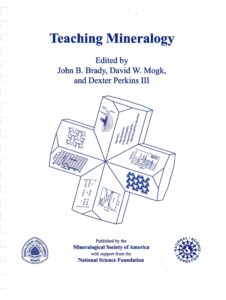

Teaching Mineralogy (now Open Access)
John B. Brady, David W. Mogk and Dexter Perkins III, editors
(2011) i-viii + 406 pages.
ISBN 978-0-939950-44-7.
This book is an outgrowth of a workshop on teaching mineralogy held at Smith College in June 1996 and sponsored by a grant from the Division of Undergraduate Education, National
Science Foundation. Seventy participants, from diverse institutional settings and from all academic ranks, met to explore common interests in improving instruction in mineralogy. Within this volume you will find numerous exercises that can be applied in the teaching of mineralogy and related courses. There are hands-on, experimental, theoretical, and analytical exercises. All have been written with the hope of optimizing student learning. The exercises in this volume provide examples of innovative ways that mineralogy can be taught using a variety of materials and teaching techniques.
This out of print Monograph is now Open Access and available for downloading




Care and Documentation of Mineral Collections
Jean F. DeMouthe
(2017) i-vi + 94 pages. ISBN 978-0-939950-99-7.
Jean Demouthe was a geologist in the Department of Invertebrate Zoology and Geology, California Academy of Science in San Francisco, CA. She worked for the Academy from October 1973 until October 2017 and held the position of Senior Collections Manager for Geology. As collection manager her responsibilities involved the organization, documentation, and storage of several million specimens, including fossils, microfossils, minerals, gemstones, and meteorites. Dr. DeMouthe also contributed to the exhibits and education programs at the Academy, and was been an active field trip leader. She taught collections management and the conservation of objects in the graduate Museum Studies program at San Francisco State University.
This work is an attempt to provide information and guidance on all aspects of caring for and documenting mineral collections, for professionals and amateurs alike. It is dedicated to everyone who shares a love of minerals, and those who care for and about collections.
View Complete Table of Contents
How I became interested in mineralogy – Jean DeMouthe (1949-2017)
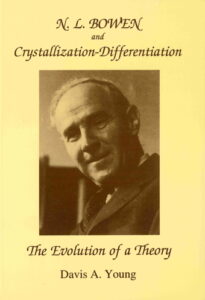

N.L. Bowen And Crystallization Differentiation: The Evolution Of A Theory
David A. Young
(1998) 276 pages. ISBN 0-939950-47-2.


WWII, Mineralogy and Me: A Memoir
F. Donald Bloss
i-xxvi + 322 pages. ISBN 978-0-939950-89-8; 0-939950-89-8.
F. Donald Bloss is a distinguished mineralogist and is the leading proponent of and scholar in the field of optical crystallography of minerals. He is one of only two individuals to hold the positions of President of the Mineralogical
Society of America and Editor-in-Chief of American Mineralogist. He is also the eponym of the mineral blossite.
WWII, Mineralogy and Me: A Memoir begins with Don growing up poor in Chicago before and during the Depression, weaves through his service as a Conscientious Objector during WWII, and follows his academic career from his early school days through his role in helping to establish perhaps the preeminent department in the mineral sciences in the world at Virginia Tech. Don traces his life through those things important to him, including family, students, colleagues, and, above all, Louise, his wife. As in most lives, there are triumphs and heart-breaking tragedies. Don also provides a front-row seat to anyone who wishes to see the evolution of optical mineralogy over the past half century.


CRYSTAL STRUCTURES I. Patterns and Symmetry
M. O’Keeffe and B.G. Hyde, Out-Of-Print
This book is devoted to the topic of the description of structures, especially periodic structures, and their symmetries. Much of the material is a prerequisite for serious students of solid state chemistry and related sciences (e.g. mineralogy, materials science and solid state physics).
Contents of Monograph 2
- Symmetry in Two Dimensions
- Three-Dimensional Point Groups
- Three-Dimensional Space Groups
- Lattice Geometry
- Polyhedra and Tilings
- Sphere and Cylinder Packing
- Nets and Infinite Polyhedra
- Appendices
